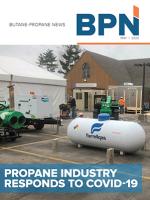Tuesday, May 19, 2020
By Jeff Thompson… Monday, April 20, 2020, made history. Crude oil for the first time ever traded negative on the NYMEX futures contract. Crude oil has traded negative on occasion for physical barrels off the NYMEX. In those cases of negative trading for physical barrels, it typically is a high-sulfur grade oil that cannot be easily refined. The underlying issue for off NYMEX negative crude oil trading and NYMEX negative trading is the same, storage.
 Typically, when a crude oil contract is getting ready to expire, a few days to a week before expiration, the market starts to work down the open interest in the contract. The open interest is simply the number of contracts outstanding for the contract month. Most of the time, with two or three days left, there might be 5000 to 20,000 contracts left in open interest. This normally is a manageable number of contracts.
Typically, when a crude oil contract is getting ready to expire, a few days to a week before expiration, the market starts to work down the open interest in the contract. The open interest is simply the number of contracts outstanding for the contract month. Most of the time, with two or three days left, there might be 5000 to 20,000 contracts left in open interest. This normally is a manageable number of contracts.
On April 20, there were over 100,000 contracts open interest on the NYMEX May WTI crude contract. This is approximately 5 to 10 times the normal number of contracts that need to be cleared before trading ends for that contract month. With the national “stay-at-home” policy in place, crude oil and refined products have started to build at a much faster pace than normal. The projections and models suggest that larger than normal builds will continue for the foreseeable future. Additionally, the expectation of normal demands even after “stay-at-home” is lifted later this year is diminishing as every week passes.
This is creating a situation globally and in the United States that crude oil and refined product storages are filling to capacity. It is hard to fully grasp how full storages are in the U.S. and world. It is reasonable to think that by the end of May or June, storages around the globe will be full. This is why the market saw the price collapse of crude oil on April 20. There is nowhere to put the crude oil. In the next 60 to 90 days, there will be even less space to put crude oil in a refinery system or storage.
So, on Monday, April 20, the market had to figure out a way to accommodate 100,000 crude oil contracts that by Tuesday afternoon would be set for physical delivery in Cushing, Okla., the site for physical delivery of NYMEX WTI crude oil contracts. The only way for this to work was for price discovery in the market. The crude market had to figure out at what price these 100,000 open interest contracts for May WTI could get cleared.
What the market found out was not appealing or welcomed. It took a move down to –$40/bbl for the crude oil market to begin to clear out all the open interest in May. This means that a buyer of May 2020 WTI crude oil had to pay a counterparty $40/bbl to take the buyer’s crude oil after the contract value going to zero. This turned into an adult version of the children’s game “hot potato”—you hold it; no, you hold it—until prices dove down far enough that open interest in May cleared.
This also tells us that on that Monday, storage costs for crude oil in Cushing ran from $40 to $60/bbl. At $60/bbl storage for May crude, with a little bit of storage possibly still available, what will the June 2020 WTI crude contract do?
Here is a scenario that could easily play out for the June 2020 contract. With little to no storage available by the time June crude oil will show up at Cushing, it is possible the market sees crude oil priced well below –$40/bbl for a period of time over the next few weeks. At this point, the propane-to-crude calculation would become completely worthless. It would be a nonsense negative number.
What this means for propane is not nonsense. This summer could be one of the worst build seasons for propane in many years or decades. With crude oil full and refiners shutdown, the propane market will quickly see how little propane can build. One thing our customers want is stability. One thing the propane market is not going to get this year on the supply side is stability. I think we have tough times ahead.
Jeff Thompson is a business management consultant at Propane Resources in Mission, Kan. Contact Jeff at (913) 262-8531 or This email address is being protected from spambots. You need JavaScript enabled to view it..

On April 20, there were over 100,000 contracts open interest on the NYMEX May WTI crude contract. This is approximately 5 to 10 times the normal number of contracts that need to be cleared before trading ends for that contract month. With the national “stay-at-home” policy in place, crude oil and refined products have started to build at a much faster pace than normal. The projections and models suggest that larger than normal builds will continue for the foreseeable future. Additionally, the expectation of normal demands even after “stay-at-home” is lifted later this year is diminishing as every week passes.
This is creating a situation globally and in the United States that crude oil and refined product storages are filling to capacity. It is hard to fully grasp how full storages are in the U.S. and world. It is reasonable to think that by the end of May or June, storages around the globe will be full. This is why the market saw the price collapse of crude oil on April 20. There is nowhere to put the crude oil. In the next 60 to 90 days, there will be even less space to put crude oil in a refinery system or storage.
So, on Monday, April 20, the market had to figure out a way to accommodate 100,000 crude oil contracts that by Tuesday afternoon would be set for physical delivery in Cushing, Okla., the site for physical delivery of NYMEX WTI crude oil contracts. The only way for this to work was for price discovery in the market. The crude market had to figure out at what price these 100,000 open interest contracts for May WTI could get cleared.
What the market found out was not appealing or welcomed. It took a move down to –$40/bbl for the crude oil market to begin to clear out all the open interest in May. This means that a buyer of May 2020 WTI crude oil had to pay a counterparty $40/bbl to take the buyer’s crude oil after the contract value going to zero. This turned into an adult version of the children’s game “hot potato”—you hold it; no, you hold it—until prices dove down far enough that open interest in May cleared.
This also tells us that on that Monday, storage costs for crude oil in Cushing ran from $40 to $60/bbl. At $60/bbl storage for May crude, with a little bit of storage possibly still available, what will the June 2020 WTI crude contract do?
Here is a scenario that could easily play out for the June 2020 contract. With little to no storage available by the time June crude oil will show up at Cushing, it is possible the market sees crude oil priced well below –$40/bbl for a period of time over the next few weeks. At this point, the propane-to-crude calculation would become completely worthless. It would be a nonsense negative number.
What this means for propane is not nonsense. This summer could be one of the worst build seasons for propane in many years or decades. With crude oil full and refiners shutdown, the propane market will quickly see how little propane can build. One thing our customers want is stability. One thing the propane market is not going to get this year on the supply side is stability. I think we have tough times ahead.
Jeff Thompson is a business management consultant at Propane Resources in Mission, Kan. Contact Jeff at (913) 262-8531 or This email address is being protected from spambots. You need JavaScript enabled to view it..


